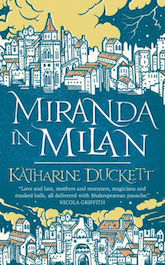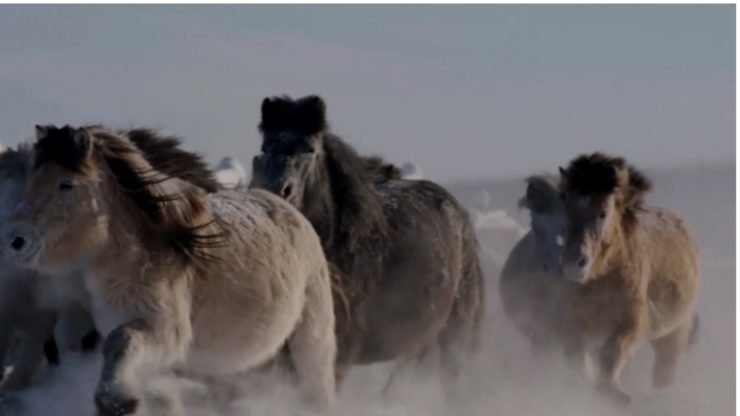The first half of the PBS show Nature’s two-hour documentary on the horse focuses mostly on the science: evolution, biology, psychology, and animal behavior. It prominently features a controversial method of training. Part Two, “Chasing the Wind,” continues with some of the science, particularly genetics, as well as history and the host’s own discipline, anthropology. It also touches on an aspect of the horse that is just about inescapable: its bond with humans and its long history as a sacred animal.
The host, Niobe Thompson, is in his element as he talks about the first meeting of human and horse. From the beginning, he says, humans saw something different from all the animals they encountered. For evidence, he points to the cave paintings of Chauvet in France, where, he says, the horse features most prominently. It even has its own small alcove, with a lovely portrait of a single horse.
For most of prehistory, horses were a source of food—not only meat but milk. And, as Thompson says, you can’t milk a wild horse. The faucets are located well up and under the mare; in order to fill your bucket of milk, you have to get right up close and into the kick zone (and your back and hindquarters are wide open to a swing-and-bite). The only way you milk a mare is with her permission.
Somewhere around 6000 BC, something changed. Humans started riding horses, and with the invention of the wheel, they also started driving them with chariots. Horses became the literal motive force for human migrations, and most of all for human wars.
What I hadn’t thought about through this era of horse-human interactions is that without humans, the horse would have become extinct. He did in North America—hunted by humans but also driven out of his native grasslands by the spread of forests after the retreat of the glaciers. In Europe the species shrank to a small population on the steppes of Central Asia. It’s here that, as far as we know, horses were first ridden and driven. And that made them indispensable to humans.
Once this happened, not only did the horse change the way humans lived and traveled—humans also changed the horse. Horses evolved to fit the environments in which humans lived, and humans created breeds to serve various purposes: agriculture, transport, war.
Buy the Book


Miranda in Milan
Environmental extremes created extreme types of horses. The two that Thompson uses for illustration are the Yakut horse of Siberia and the Arabian horse of the desert. The Yakut people are descended from Mongols who fled the dissolution of their empire and ended up in the bitter cold of Siberia. Their horses, already small and tough, became truly cold-adapted organisms, with shorter legs, thicker bodies, and luxuriant coats, plus an ability to slow their metabolism almost to the point of hibernation while still managing to stay upright and functioning.
The Arabian by contrast is one of the oldest known breeds, and has evolved for survival in the desert. Its long legs, large nostrils, thin fine coat, and high-set tail are all designed to keep the animal cool in extreme heat. Thompson takes time to rhapsodize on how “gorgeous” it is, too—especially in contrast to the stocky little Yakut horse. Personally I see the beauty in both. They’re well suited to their very different environments.
There are other extremes of horse type as well: the tiny Mini, the huge draft breeds. Thompson cites the Belgian as being one of the largest breeds, and so it is; it’s built to pull, and it’s a star of agricultural work. Then of course he gets into the Thoroughbred again, as a master of speed, and he takes time to praise his favorite breed, the Quarter Horse. He gives a few quick tips of the hat to “aristocratic” breeds, such as the European Warmblood, and there’s a pretty picture of an American Saddlebred, but he doesn’t name-check that one. And then he mentions the Friesian as the mount of the medieval knight, but now it’s all about the pretty.
Which, no. Pretty, oh yes. If you’ve seen Ladyhawke you’ve seen a Friesian: Navarre’s warhorse is a splendid example of the breed. But, notwithstanding this completely fictional and totally modern take on medieval fantasy, these beautiful black horses with their flowing hair and their famously sweet temperament were bred to pull funeral coaches in early modern Belgium. The Great Horse of the western knight was much more probably an ancestor of the Percheron or the Shire horse. Even in Ladyhawke, the enemy knight’s white horse in the battle in the chapel is a more accurate representation of the medieval and early modern aristocratic breeds.
Breed myths are a thing. The actual horse of royalty from the Middle Ages through the early modern era would be the Spanish horse, the ancestor of the Andalusian and the Lusitano. That’s what the bad-guy knight is riding in the film. Thompson doesn’t mention these horses at all, though they’re represented in the pretty pictures that accompany his narration about breeds (they’re the grey ones with the long manes, the non-hairy legs, and the straight profiles; if the profile is concave or dished, that’s an Arabian).
And then, well, first, the European Warmblood is not a breed, it’s a type bred to a state standard, and second, it only became all the rage for show jumping in the past couple of decades. Prior to that, jumpers tended to be Thoroughbreds (because Thoroughbreds can do a lot more than race—they were and still are superlative jumpers, hunters, eventers, and competitive dressage horses). The Warmblood Verbands were formed after World War II when both agriculture and war had gone to the machines. Farmers and breeders had to find a way to survive. They systematically set out to breed horses for sport. Their former farm animals, their cavalry horses, their coach horses, were crossed with whatever breeds and types might best achieve the standard they were aiming for—there’s a lot of Thoroughbred in the modern Warmblood.
And they succeeded. They took over dressage, they took over jumping. They changed these sports, altered their standards and their performance expectations. But from a historical standpoint, that’s a quite late development.
One thing this episode does point out about breeding is absolutely true, and it’s causing serious problems in quite a number of breeds. That is the issue of inbreeding and the need for genetic diversity. The reference in the episode is to an Irish scientist who has isolated what Thompson refers to as the “Speed Gene,” and she has found it in one particular stallion. That stallion is siring literally hundreds of offspring.
And that’s a problem. The smaller a gene pool gets, the more it concentrates in a single line, the harder it becomes to avoid inbreeding, and the more likely it is that genetic faults will pervade the breed or the species. The episode doesn’t go into detail, and I’m sure the legal department had some say in that.
There are some notorious examples of “hot-stallion” syndrome in the larger and more lucrative breeds. In the Quarter Horse, a tremendously popular halter stallion carried a mutation that gave him hugely exaggerated and very fashionable muscles, but when concentrated by inbreeding, caused some of his descendants to collapse with uncontrollable and acutely painful, sometimes fatal muscle spasms. And that’s only one example.
It’s good that the episode makes this point, because it’s important. The survival of the horse requires genetic diversity, and apart from a very few feral populations, horses are a human creation. It’s on us to avoid the allure of fad and fashion and focus on the future of the species.
And that’s not just science. It’s the human heart, too. Humans and horses have a unique bond. Thompson calls it a “perfect partnership.” Even now that horses are no longer the center of mainstream culture, they’re still very much a part of how that culture evolved. “The human story,” said Thompson, “is a horse story.”
Maybe not universally. But it’s certainly true of the human cultures that radiated outward from Central Asia around about 6000 BC—all the way back to North America and Native tribes’ wholehearted embrace of the horse.
Judith Tarr is a lifelong horse person. She supports her habit by writing works of fantasy and science fiction as well as historical novels, many of which have been published as ebooks by Book View Cafe. She’s even written a primer for writers who want to write about horses: Writing Horses: The Fine Art of Getting It Right. Her most recent short novel, Dragons in the Earth, features a herd of magical horses, and her space opera, Forgotten Suns, features both terrestrial horses and an alien horselike species (and space whales!). She lives near Tucson, Arizona with a herd of Lipizzans, a clowder of cats, and a blue-eyed dog.










